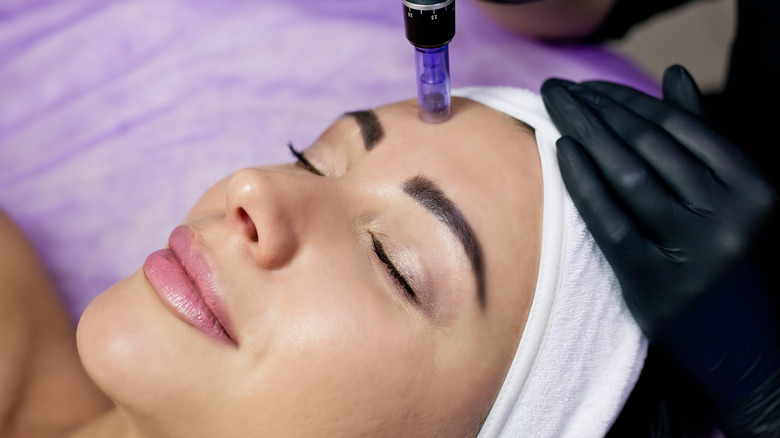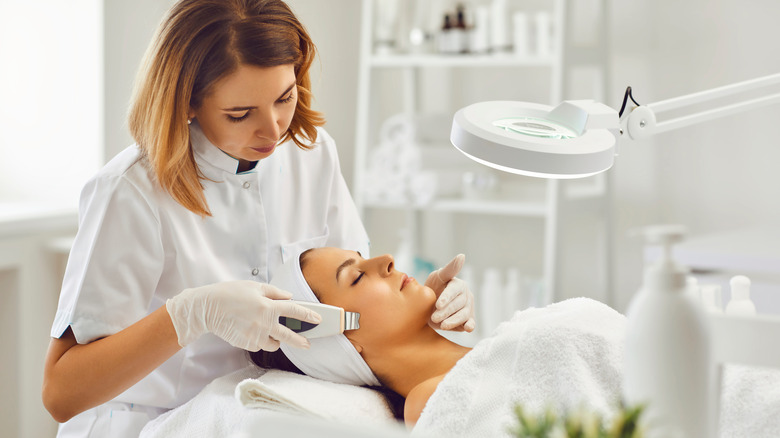The Real Difference Between An Oxygen Facial And A HydraFacial
Getting a facial is one of the best ways to pamper yourself. Whether you get a facial to improve your skin's texture or tackle acne, nothing beats the after-effects of such treatments. After all, "nothing you do at home can replace professional attention," says celebrity esthetician Joanna Vargas (via Allure). Nowadays, there are numerous facials targeted for various skin issues and experts use different machines for different facial techniques — just like the oxygen facial and the HydraFacial. While the two treatments offer similar benefits, they are not one and the same.
"HydraFacial uncovers a new layer of skin with gentle exfoliation and relaxing resurfacing," says board-certified cosmetic dermatologist Dr. Ariel Ostad. The treatment usually takes an hour and is divided into three steps (via Elle). Meanwhile, oxygen facials use, well... oxygen to hydrate the skin, making it plump and healthy. But experts now offer a new and improved version of the treatment: OxyGeneo. Unlike the oxygen facial, OxyGeneo does not pump CO2 into the skin. Instead, it draws out oxygen from the skin, which is less damaging (via Elemental Esthetics).
"The OxyGeneo three-in-one super facial works upon the natural process of our body to oxygenate the skin from within," says physicist and co-founder of beauty supply company DermaSpark Moshe, Ben-Shlomo, MSc (via Byrdie). Here's what you should know.
Exfoliation with HydraFacial is less effective than OxyGeneo
When getting a HydraFacial, estheticians use a specific wand and a serum that removes dead skin cells. Unlike microdermabrasion, the treatment is less painful, as experts do not do manual extraction (via Elle). But while it sounds promising, there are some downsides to this facial. "I never felt like it penetrated the skin that deeply. I didn't see much actual improvement in blackhead or acne issues," explains Jennifer Warmann-Bloss of Elemental Esthetics. "In fact, it was necessary to do extractions with this treatment to really get the skin clean."
OxyGeneo, on the other hand, offers gentle exfoliation with the help of a microderm-like tool. Unlike HydraFacial, it has "no harsh vacuum procedure." Even without using traditional extraction, you can still "get the exfoliation benefits of microdermabrasion" with this facial (via OxyGeneo). But that does not mean people with highly sensitive skin can't have HydraFacial. In fact, the treatment is "customizable," says cosmetic dermatologist Dr. Ariel Ostad. Meaning, estheticians can tweak the intensity of the treatment depending on your skin. Then again, you might want to consider how much dead skin cells you need extracted and, most importantly, your skin condition. Experts suggest staying away from HydraFacial if you have sunburn, rosacea, and active rashes to avoid damaging the skin further.
The effects of OxyGeneo last longer than HydraFacial
Both HydraFacial and OxyGeneo help reduce pores, brighten hyperpigmentation, hydrate the skin, and improve the skin's texture (via Byrdie). The treatments also help with wrinkles and skin cell production (per Elemental Esthetics). While they offer similar results, their prices vary. Depending on your needs, a HydraFacial costs about $199 up to $300 per session, while you can get OxyGeneo for $125 to $200. However, it's important to take note that the price range will differ from spa to spa.
Facials are certainly not cheap, so they are an investment. But how long do they last? For HydraFacial, the fresh feeling of smoothness and hydration on the skin can last up to seven days, if not longer. To fully enjoy its optimal results, experts suggest getting the treatment done once a month. As for OxyGeneo, the effects will last from four to six weeks and it can stretch up to three months. But like HydraFacial, maintenance every four to six weeks is highly advised to reap its complete benefits (via Reclaim MedSpa).


